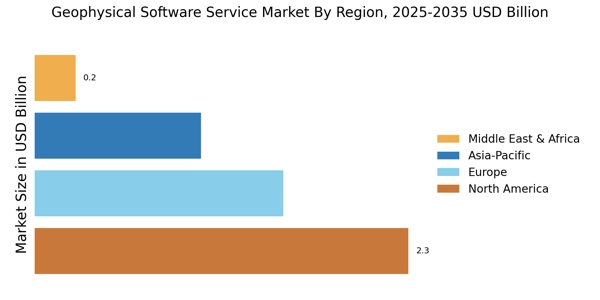The Geophysical Software Service Market is characterized by a dynamic competitive landscape, driven by technological advancements and increasing demand for efficient resource exploration. Key players such as Schlumberger (US), Halliburton (US), and CGG (FR) are at the forefront, each adopting distinct strategies to enhance their market positioning. Schlumberger (US) focuses on innovation through the integration of artificial intelligence and machine learning into its software solutions, aiming to improve data analysis and interpretation. Halliburton (US), on the other hand, emphasizes strategic partnerships and collaborations to expand its service offerings and geographical reach. CGG (FR) is actively pursuing digital transformation initiatives, enhancing its cloud-based services to provide clients with more accessible and efficient geophysical data management. Collectively, these strategies not only bolster individual company growth but also intensify competition within the market, as firms strive to differentiate themselves through technological prowess and service quality.
The business tactics employed by these companies reflect a nuanced understanding of market demands. For instance, localizing software development and optimizing supply chains are critical for enhancing responsiveness to client needs. The competitive structure of the Geophysical Software Service Market appears moderately fragmented, with several players vying for market share. However, the influence of major companies is substantial, as they set industry standards and drive innovation, thereby shaping the overall market dynamics.
In August 2025, Schlumberger (US) announced a strategic partnership with a leading AI firm to develop next-generation geophysical modeling software. This collaboration is poised to enhance Schlumberger's capabilities in predictive analytics, allowing clients to make more informed decisions regarding resource exploration. The integration of advanced AI technologies is likely to position Schlumberger as a leader in the market, reinforcing its commitment to innovation and client-centric solutions.
In September 2025, Halliburton (US) launched a new cloud-based platform designed to streamline data sharing and collaboration among geophysical teams. This initiative not only reflects Halliburton's focus on digital transformation but also addresses the growing need for real-time data access in the industry. By facilitating seamless communication and data exchange, Halliburton aims to enhance operational efficiency and reduce project turnaround times, thereby strengthening its competitive edge.
In July 2025, CGG (FR) unveiled a comprehensive suite of software tools aimed at improving environmental sustainability in geophysical operations. This initiative aligns with the increasing emphasis on sustainable practices within the industry, as clients seek solutions that minimize environmental impact. By prioritizing sustainability, CGG not only meets regulatory demands but also positions itself favorably among environmentally conscious clients, potentially expanding its market share.
As of October 2025, the Geophysical Software Service Market is witnessing a pronounced shift towards digitalization, sustainability, and the integration of artificial intelligence. Strategic alliances are becoming increasingly pivotal, as companies recognize the value of collaborative innovation in enhancing service offerings. Looking ahead, competitive differentiation is likely to evolve, with a greater emphasis on technological innovation and supply chain reliability, rather than solely on price. This shift suggests that companies that prioritize R&D and sustainable practices will be better positioned to thrive in an increasingly competitive landscape.


















Leave a Comment